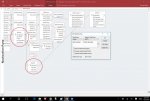Hi,new to the forum and novice access user.
I have a number of tables in by database with the main one being tblsites with the PK Site number. I am trying to create a relation to the table tblNTP with the PK site number. I have used the same format for other relationships within the database with any issue however this one does not want to cooperate. I have attached copies of the tables and the relationships for your viewing. If anyone can provide assistance I would greatly appreciate it!
Thanks
I have a number of tables in by database with the main one being tblsites with the PK Site number. I am trying to create a relation to the table tblNTP with the PK site number. I have used the same format for other relationships within the database with any issue however this one does not want to cooperate. I have attached copies of the tables and the relationships for your viewing. If anyone can provide assistance I would greatly appreciate it!
Thanks



